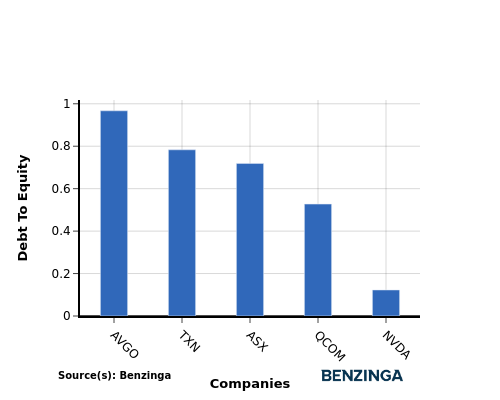Inquiry Into NVIDIA's Competitor Dynamics In Semiconductors & Semiconductor Equipment Industry
In today's rapidly evolving and fiercely competitive business landscape, it is crucial for investors and industry analysts to conduct comprehensive company evaluations. In this article, we will undertake an in-depth industry comparison, assessing NVIDIA (NASDAQ:NVDA) alongside its primary competitors in the Semiconductors & Semiconductor Equipment industry. By meticulously examining crucial financial indicators, market positioning, and growth potential, we aim to provide valuable insights to investors and shed light on company's performance within the industry.
NVIDIA Background
Nvidia is a leading developer of graphics processing units. Traditionally, GPUs were used to enhance the experience on computing platforms, most notably in gaming applications on PCs. GPU use cases have since emerged as important semiconductors used in artificial intelligence. Nvidia not only offers AI GPUs, but also a software platform, Cuda, used for AI model development and training. Nvidia is also expanding its data center networking solutions, helping to tie GPUs together to handle complex workloads.
| Company | P/E | P/B | P/S | ROE | EBITDA (in billions) | Gross Profit (in billions) | Revenue Growth |
|---|---|---|---|---|---|---|---|
| NVIDIA Corp | 55.06 | 49.65 | 28.43 | 23.01% | $22.58 | $26.67 | 69.18% |
| Broadcom Inc | 102.53 | 18.99 | 23.78 | 7.12% | $8.02 | $10.2 | 20.16% |
| Taiwan Semiconductor Manufacturing Co Ltd | 27.77 | 7.87 | 11.44 | 8.19% | $608.71 | $493.4 | 41.61% |
| Advanced Micro Devices Inc | 113.58 | 4.36 | 9.16 | 1.23% | $1.59 | $3.74 | 35.9% |
| Texas Instruments Inc | 41.36 | 12.09 | 12.50 | 7.08% | $1.85 | $2.31 | 11.14% |
| Qualcomm Inc | 15.74 | 6.11 | 4.10 | 10.3% | $3.67 | $6.04 | 16.93% |
| ARM Holdings PLC | 196.15 | 22.79 | 39.03 | 3.17% | $0.46 | $1.21 | 33.73% |
| Micron Technology Inc | 21.64 | 2.65 | 4.02 | 3.79% | $4.33 | $3.51 | 36.56% |
| Analog Devices Inc | 65.33 | 3.41 | 12.21 | 1.63% | $1.2 | $1.61 | 22.28% |
| Monolithic Power Systems Inc | 19.14 | 10.52 | 14.61 | 4.17% | $0.18 | $0.35 | 39.24% |
| STMicroelectronics NV | 26.71 | 1.59 | 2.40 | 0.32% | $0.51 | $0.84 | -27.36% |
| ON Semiconductor Corp | 40.92 | 3.07 | 3.79 | -5.78% | $-0.37 | $0.29 | -22.39% |
| ASE Technology Holding Co Ltd | 19.86 | 2.10 | 1.08 | 2.39% | $27.16 | $24.89 | 11.56% |
| United Microelectronics Corp | 11.73 | 1.41 | 2.30 | 2.06% | $23.86 | $15.45 | 5.91% |
| First Solar Inc | 14.61 | 2.25 | 4.34 | 2.59% | $0.35 | $0.34 | 6.35% |
| Credo Technology Group Holding Ltd | 353.76 | 25.84 | 42.55 | 5.63% | $0.04 | $0.11 | 179.73% |
| Skyworks Solutions Inc | 28.50 | 1.84 | 2.97 | 1.11% | $0.22 | $0.39 | -8.87% |
| Qorvo Inc | 150.05 | 2.38 | 2.23 | 0.93% | $0.11 | $0.37 | -7.6% |
| Universal Display Corp | 31.53 | 4.34 | 11.14 | 3.93% | $0.08 | $0.13 | 0.62% |
| Lattice Semiconductor Corp | 140.76 | 10.12 | 14.73 | 0.71% | $0.02 | $0.08 | -14.68% |
| Average | 74.82 | 7.56 | 11.49 | 3.19% | $35.89 | $29.75 | 20.04% |
By conducting an in-depth analysis of NVIDIA, we can identify the following trends:
-
A Price to Earnings ratio of 55.06 significantly below the industry average by 0.74x suggests undervaluation. This can make the stock appealing for those seeking growth.
-
With a Price to Book ratio of 49.65, which is 6.57x the industry average, NVIDIA might be considered overvalued in terms of its book value, as it is trading at a higher multiple compared to its industry peers.
-
With a relatively high Price to Sales ratio of 28.43, which is 2.47x the industry average, the stock might be considered overvalued based on sales performance.
-
The Return on Equity (ROE) of 23.01% is 19.82% above the industry average, highlighting efficient use of equity to generate profits.
-
The company has lower Earnings Before Interest, Taxes, Depreciation, and Amortization (EBITDA) of $22.58 Billion, which is 0.63x below the industry average. This potentially indicates lower profitability or financial challenges.
-
The company has lower gross profit of $26.67 Billion, which indicates 0.9x below the industry average. This potentially indicates lower revenue after accounting for production costs.
-
The company is experiencing remarkable revenue growth, with a rate of 69.18%, outperforming the industry average of 20.04%.
Debt To Equity Ratio

The debt-to-equity (D/E) ratio is a key indicator of a company's financial health and its reliance on debt financing.
Considering the debt-to-equity ratio in industry comparisons allows for a concise evaluation of a company's financial health and risk profile, aiding in informed decision-making.
When comparing NVIDIA with its top 4 peers based on the Debt-to-Equity ratio, the following insights can be observed:
-
When considering the debt-to-equity ratio, NVIDIA exhibits a stronger financial position compared to its top 4 peers.
-
This indicates that the company has a favorable balance between debt and equity, with a lower debt-to-equity ratio of 0.12, which can be perceived as a positive aspect by investors.
Key Takeaways
For NVIDIA in the Semiconductors & Semiconductor Equipment industry, the PE ratio is low compared to peers, indicating potential undervaluation. The high PB and PS ratios suggest strong market sentiment and revenue multiples. In terms of ROE, NVIDIA outperforms peers, reflecting efficient use of shareholder equity. However, the low EBITDA and gross profit levels may indicate operational challenges. The high revenue growth rate highlights NVIDIA's strong sales performance relative to industry competitors.
This article was generated by Benzinga's automated content engine and reviewed by an editor.
Posted-In: BZI-IANews Markets Trading Ideas



